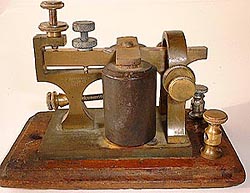|
|
Railroad
Telegraphy Devices
For a long time after the telegraph was installed on the
railroads, the operators were required to get the incoming message on
a device called a "register" that would print the dashes
and dots allowing the telegraph men to see the message during decode.
The more experienced operators got to be able to "read" the
code on the fly just by listening to the small sounds the register made.
An upper level Erie Railroad division supervisor once observed this happening
(it was strictly forbidden), and set up a series of test messages that
were all decoded by "ear" without error. From then on the operators
were allowed to do away with the paper tape that had the code marks and
just listen to the clicks. Eventually the resister was redesigned into
the sounder (no paper tape, louder clicks).
The device used to generate (as opposed to receive a telegraph
signal a "key". Railroad telegraphers became especially
adept as using the key and could transmit information at great speed.
The telegraph was eventually replaced by the telephone in railroad operations (See note below),
but not before a generations of railroaders spent whole careers mastering
the skills needed in the use of morse code.
Shown below are some rare telegraphy devices used in railroad
operations. These devices are from the Clyde Conrow collection. Information
and photos are courtesy of Tom Stranko. Additional telegraphy items are
shown on a second and third page.
|
|
Above: Two views of a "Goodyear" Sounder. |
 |
|
Above: A "Longstreet" sounder
marked "N.Y.O.& W. RY" for the
New York, Ontario & Western Railway. |
|
|
Above: A telegraph "register" unit,
made in Utica, NY by the Chubbuck Co. |
|
|
Above: A "duplex" key or "double speed" key,
a device that has a contact on both sides of the key arm. In April, 2014 we received the following comment: The "double speed key" was invented and offered as an alternative to the "straight key". Telegraphers using a straight key over a long period of time developed Carpal Tunnel syndrome. The "double speed key" was a SIDESWIPER and often referred to as a "cootie key. The simplest definition is: a double – sided single key. There is no flexing of the fingers or the wrist! (NO RSI – nor deverlopment of a GLASS FIST which was a serious problem." [Thanks to GLS for the comment!]
|
|
|
Above: Two views of a "G.M.
Phelps" Sounder. |
|
Left: A "pump" key which could be operated from
any direction and quickly. An "easy to use" telegraph key.
The key is the device that creates the code signal. |
Note. In late summer 2007, we received this note: "Your statement about the telegraph being replaced by the telephone is not altogether true. I was an Agent Operator, a telegrapher working interlocking plants for signals, switches, copying train orders for the train crews to operate on, telegraphing train consists to the next terminal etc. I was a ticket agent..still using the telegraph, and transmitting messages from the trains to other railroad offices. I was a mobile agent and also an assistant freight agent with many varied duties whereby I used a base radio to contact the mobile agents in the area and instruct trains if need be. When I was working as a ticket agent I was also the assistant freight agent. I think the thing that really replaced the telegraph was the telex machine....I used one during my eight hours of duty. Then came the radios in addition to all this and also added was the computer. I came up through most of this stuff. For years the biggest part of my job was telegraph. And not bragging, I must say I was one of the best. I worked with 5 train dispatchers during my tour of duty coping train orders. I never had to ask anyone to slow down or repeat themselves. Thanks to a dear RED HEAD LADY who helped me build my speed up to where I could that. So Long." [Thanks to KW for the note]
Thanks to Tom Stranko for the other material on this page.
Page Two on Telegraphy Items
Page Three on Telegraphy Items
|